Editorial: Health Care and Healthy Eating
by Robert S. Ellwood

In The Peaceable Table we feel called to focus primarily on compassion for and celebration of our much-abused animal cousins. But "all animals are equal;" our hearts care no less for the welfare of our human sisters and brothers. The horrendous practices of factory farming, transportation, and rapid mass killing have not only subjected billions of our innocent cousins to hell on earth: by making animal products cheaper, more perilous, and more abundant than ever before, they have subjected ever-increasing myriads of human beings to crippling and catastrophic illness. This situation in turn greatly increases the scale of animal experimentation in the search for new pharmaceuticals for an ever-expanding market; and it has put huge pressure on human health care systems.
In the United States, the hot political topic over the summer of 2009 has been reforming our malfunctioning system of health care, and paying for it. Congress is tied up in knots over the issue. A great many people acknowledge that something is badly wrong. To begins with, the U.S. leads the world in expenditures for health. Nearly 16% of national and personal income goes directly or indirectly into medical costs, including insurance, the Medicare portion of Social Security, co-payments, medications, and so on and on, compared to 11.6% in Switzerland, the next-highest nation; 8% in Britain; just 3% in Canada. Yet the United States ranks only seventeenth in the world in health statistics, and despite the vast sums being spent, far too many citizens are uninsured or only precariously insured.
With so much money -- one-sixth of all the dollars in the country -- at stake, it is no surprise that powerful and well-financed interests are colliding around the health, or lack thereof, of the US-American citizen. These include insurance companies, pharmaceutical firms, physicians and other medical professionals, hospitals, employers, government agencies, and of course the political parties. One can only hope for a solution a little better than another something-for-everyone-nothing-really-resolved compromise to come out of such a battle of well-matched behemoths in the short term. This is not the place to deal with the strictly political and economic aspects of the mess. It is, however, appropriate for The Peaceable Table to go behind the scenes to examine the deep background of our Republic's health crisis.
To do this, let's first ask two seldom-asked basic questions: first, Why do so many need such intensive health care anyway? and second, why does it cost so much? The answer to both, in our view, lies in the relation between lifestyle (especially eating and drinking) and health, and no less in the medical emphasis on crisis intervention rather than prevention.
A front-page headline in USA Today, the nation's largest circulating newspaper, for July 28 read, "Obesity is a key link to soaring health tab." It said that obesity, a widely-recognized epidemic, now accounts for nearly 10% of health costs -- up from 6.8% in 1998 -- and so makes for a sizable part of that 16% of national income going to sickness.
 Interestingly, an article in The Chicago Tribune on the same day pointed to the matter of obese physicians, who do not practice what they presumably know they ought to preach -- though the article did acknowledge that many patients find something comforting in a comfortably portly caregiver. (We might add, however, that an obese physician implicitly gives the client/patient permission to keep eating badly.)
Interestingly, an article in The Chicago Tribune on the same day pointed to the matter of obese physicians, who do not practice what they presumably know they ought to preach -- though the article did acknowledge that many patients find something comforting in a comfortably portly caregiver. (We might add, however, that an obese physician implicitly gives the client/patient permission to keep eating badly.)
If one go on to consider the further medical costs of problems fundamentally created by lifestyle choices, such as major cancers and coronary heart disease mostly caused by eating animal products and high-fat refined foods instead of whole plant foods, or the well-known likely paybacks of heavy alcohol and tobacco use and unmanaged stress, I am sure we could explain much the 16% of national income. We could envision that grossly obese figure slimmed down to a manageable percentile if everyone (or even most of us) lived and ate wisely and compassionately.
Then comes the observation that medical practice by and large is oriented toward complicated, and very expensive, intervention when the results of lifestyle choices finally threaten well-being or life itself: bypass surgery; pharmaceutical cocktails to control blood pressure; radiation, chemo, or surgical attacks on cancer (also increasingly recognized to be an uninvited guest at the modern table, a sickly fruit of pollution, sedentary ways, and bad diet); and the like. These dramatic procedures of course highlight the doctor's skill, and can sometimes produce good outcomes. Yet, though they undoubtedly add several points to the 16%, much of the time--perhaps most--they are not inherently necessary. We need instead to emphasize prevention, which a change to a responsible insurance program would motivate.
We are not, of course, denying the need of some highly professional medical care. In an imperfect world, there will always be congenital defects, accidents, virtually unavoidable infections and infectious diseases, and much else requiring such care, and it ought to be equally available to all. But that goal would be much more easily reached if the inordinate influence of big-money interest in food production and in health (or rather in sickness) were proportionately lessened. That would take place if the vast sway of "elective" illnesses were greatly reduced by the policies of eating and living consistently advocated by The Peaceable Table and similar voices.
Let your own voice be heard.
For those concerned about the harm alcoholic drinks can do, I have it on Good Authority that the bottles at the Christmas feast pictured above contain sparkling cider.--Editor
Unset Gems
 “Animals can communicate quite well . . . . And generally speaking, they are ignored.” ~ Alice Walker
“Animals can communicate quite well . . . . And generally speaking, they are ignored.” ~ Alice Walker
-- contributed by Lorena Mucke
"The young do not know enough to be prudent, and therefore they attempt the impossible--and achieve it--generation after generation." - Pearl Buck
--Contributed by Benjamin Urrutia
News Notes
The Animal Issue Goes Mainstream
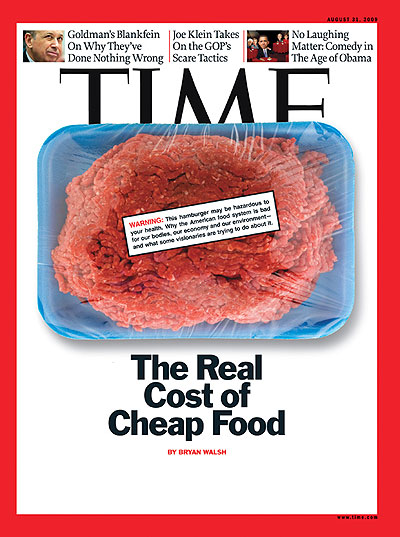 Time Magazine’s cover story “The Real Cost of Cheap Food” exposes the suffering farmed animals endure on a daily basis, and the reason behind it: demand for cheap food. From the overuse of antibiotics and hormones, to what farmed animals are fed, this article covers the major issues surrounding modern agriculture and the negative effects on our health, animals and the environment. See Real Cost.
Time Magazine’s cover story “The Real Cost of Cheap Food” exposes the suffering farmed animals endure on a daily basis, and the reason behind it: demand for cheap food. From the overuse of antibiotics and hormones, to what farmed animals are fed, this article covers the major issues surrounding modern agriculture and the negative effects on our health, animals and the environment. See Real Cost.
--Contributed by Lorena Mucke
A Helping Hand for Health in Yuma
Our own Jean Myers, who wrote the guest editorial "Therefore Choose Life: Teaching in the Cancer Project" in Oct. 2006 (see PT issue25) and told her family's pilgrimage story in the Nov. 2006 issue (see PT issue26), is featured, together with her husband Carl Myers, M.D., in the "Physician Profile" column of the current issue of Responsible Medicine, the quarterly periodical of the Physician's Committee for Responsible Medicine. The article describes Carl Myers' emphasis on diet education in his medical practice, and Jean Myers' work teaching the Cancer Project's nutrition and cooking class series. The article also describes "Nature's Express," the Myers' small chain of vegan fast-food restaurants.
Congratulations, Jean and Carl Myers!
Out of (and Into) the The Mouths of Babes

Brooke English, a youthful Florida resident who loves animals, decided to forgo an outing to the circus two years ago after seeing a picture of a chained elephant. Not long afterwards, still all of four, she gave up eating meat. Although her mother Heidi still eats some meat, she's very supportive of her daughter's diet and agrees that Brooke is "... 100 percent right." Willing to learn from her wise daughter, the mother has cut down, and we have good reason to hope that she will match her young teacher's self-discipline, and cut out the corpses. See Brooke.
--Contributed by Lorena Mucke
Pioneering Friends to Speak
On First-Day, 27 September 2009, Sherry and Bob Madrone of Apple Seed Monthly Meeting will visit San Francisco Meeting to hold a talk on how a plant-based diet is in harmony with Friends’ testimonies. For more information, please contact the speakers at madrone@netzero.net.
The Madrones' Pioneer narrative will appear in the October PT.
Letters
Dear Peaceable Friends,
It is a truly wonderful newsletter again! I especially loved your article on Jane Austen . . . must re-read Mansfield Park. And I ordered a copy of The Inner World of Farm Animals for a great-grandson.
I also loved the review of Wesley, the Owl. Made me smile warmly to remember the love I had for my wonderful talking raven . . . . How I was amazed at his intelligence, at his moods . . . his very deep and obvious feelings. He would hunker down in abject depression sometimes, and I would feel so terrible because he couldn't fly . . . the artist who gave him to me had clipped his wings and told me he couldn't survive in the wild as she had bought him from two little boys who had stolen the baby from a nest. (He lived in a very small cage for the first two years; he was seven when I got him) But I discovered it wasn't true! I could never bring myself to clip his wings myself...and when the former "owner" was out of the country at length, (she used to come clip them periodically) they grew back. One day he flew over the wall and found a home in a tree at the foot of my mountain . . . .
--Betse Streng
See Betse's animal-friendly version of "Sing a Song of Sixpence " in PT issue29 , and her "Pilgrimage" account in PT issue51.
Dear Peaceable Friends,
I read and reread the July-August PT. The editorial made me realize just how badly humankind does need to find its unity amongst itself, other beings, and the stars. . . . I especially enjoyed the way you wrapped it up with your statement about developing unwavering conviction that will "empower us to take liberating action on behalf of both our human and our animal kin . . . even when the stars are invisible in the light of common day." This is such a well-expressed conviction that I've read and reread the essay just to get to that wonderful ending, and to consider how I might incorporate that eyes-on-the-invisible-goal ideal into my life.
The clear sky that was seen by Miss Price has been so diminished by "light pollution" that, although I currently live away from any large city, there is still only a smattering of stars in the night sky here.
. . . . The book review of Wesley the Owl again shows how animals are so clearly beyond the level of consciousness generally credited to them; it makes me wish such books received wider readership, as I feel they could start people on pilgrimages of their own.
I pray that you mind is on the Lord, that your heart is filled with love, and your soul embraced by God's mercy.
God bless us, every one--
Carl Sheppard
See Carl's "My Pilgrimage" narrative in PT issue54 .
Glimpses of the Peaceable Kingdom
Under Her Wings
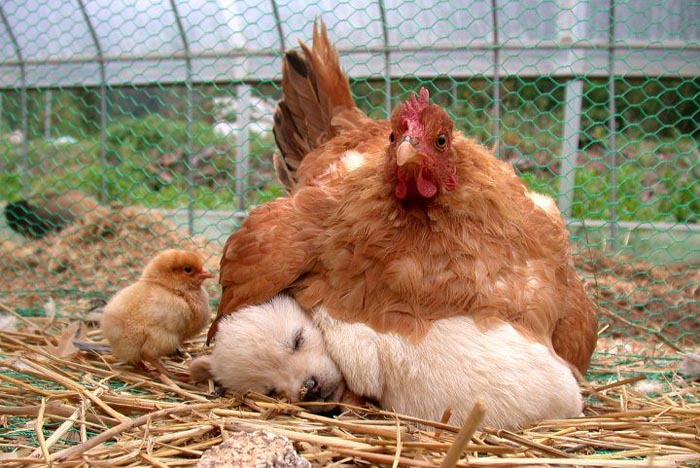
I am safely abiding . . .
--Contributed by Virginia Iris Holmes
Friends at First Sight
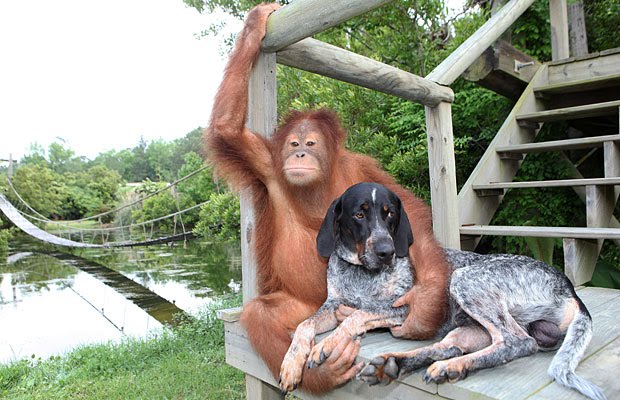
Suriya, an orangutan residing at a preserve for endangered animals in South Carolina, while taking an elephant ride with his human two years ago met an emaciated Blue Tick hound. The dog showed none of the wariness dogs usually do when encountering primates or elephants; he came right over, while Suriya jumped down and embraced him as though they were long-lost friends. Since then they have become very close, swimming, tumbling, and taking walks together almost every day. See a film clip at Suriya.
The clip points out that orangutans are endangered due to excessive palm-oil tree planting in southeast Asia; it encourages consumers to avoid contributing to the problem.
--Contributed by Marjorie Emerson and Barbara Booth
There have been reports that in South America, native peoples are also being forced out of their homes by palm planters. Let's check ingredients before buying, and stay away from products containing palm oil unless we are sure they are responsibly sourced.
Book Review: The Emotional Lives of Animals
Marc Bekoff. The Emotional Lives of Animals. Foreword by Jane Goodall. New World Library. Novato, California. 2007. 215 plus xxi pp. Hardcover. $23.95.
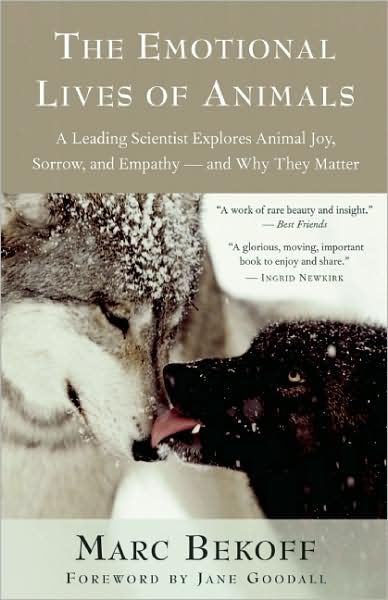 In her Foreword, Jane Goodall describes the time when she was working for her degree and the august faculty of Cambridge would give her grief for describing a chimpanzee mother as a "she" instead of an "it," as the prevailing dogma of the zeitgeist demanded. Things are a bit better now in academia, but there is still a long way to go.
In her Foreword, Jane Goodall describes the time when she was working for her degree and the august faculty of Cambridge would give her grief for describing a chimpanzee mother as a "she" instead of an "it," as the prevailing dogma of the zeitgeist demanded. Things are a bit better now in academia, but there is still a long way to go.
In his Preface, Bekoff informs us of a recent scientific discovery: the orcas and several species of whales have a greater number of spindle cells in their brains than humans do. These cells are important for processing emotions, feeling empathy, social organization, etc. So, strictly from a scientific point of view, these cetaceans can be seen as being more evolved emotionally and socially than we are. (Page xix).
The first chapter, "The Case for Animal Emotions and Why They Matter," includes two moving examples that will be familiar to readers of Peaceable Table. On page 3 we find data from the study by Iain Douglas-Hamilton of the elephants at the Samburu Reserve. (For more on this subject, see the review of a National Geographic article in PT issue 47. On page 17, we read about Aochan the rat snake and Gohan the dwarf hamster - two friends whom we have also met in a previous issue (see PT issue 20). Pages 25- 27 tell in in brief the story of Jasper, a bear who was cruelly abused and exploited by humans for years, but is free and happy today. Regrettably, the photos of Jasper, and the color photograph of two wolves on the cover, are the only illustrations in the book.
In Chapter 2 Bekoff gives us a brief history and explanation of cognitive ethology, defined as "the comparative, evolutionary, and ecological study of animal minds." (Page 30). In other words, a science that would not even be allowed to exist if the Aristotelian dogmatists had their way. It is traced back to Charles Darwin, who believed that the human mind evolved from the animal mind (later replaced by a sort of atheistic creationism - a belief that human ideas and emotions were self-created out of nothing ).
Chapter 3 explores "Beastly Passions: What Animals Feel." On page 45, we learn more about the the wolves who are the stars of the book's cover photo. They are Motomo, a wolf of the middle rank, and Kamots, the patriarch of the pack. Motomo is lovingly and submissively kissing Kamots. On page 82, we are told the story of Franz, a chimpanzee kept in a cage who outsmarted and outpranked one of his human tormentors. Good for Franz, I say.
Chapter 5 explores the challenges of answering the "skeptics" - who are in many cases really not skeptics at all, but unbending dogmatists. This can be seen, for example, in the story on pages 126-127 in which zoo elephants were asserted uncritically to be "happy" by the same authorities who objected to the claims of animal activists that the animals were unhappy.
This book is recommended for all except very young children. The best audience for it will be people who are still deciding whether to adopt a nonviolent diet. Hopefully Bekoff's stories and arguments will convince intelligent and compassionate readers that they should commit to a lifestyle that does not add to the injustice, pain and suffering in the world.
I would recommend creating a version of this book for younger children, adding more photos and drawings, simplifying the vocabulary where it gets technical. Children, after all, are far more easily persuaded to respect the lives of animals than grownups are. "As the twig is bent, so is the tree inclined." Any language or lifestyle is more easily learned and adopted by a toddler than by the wisest grey-haired professor.
--Benjamin Urrutia
Book Review: Scat
Scat. A novel for young people by Carl Hiaasen. New York: Knopf, 2009. 372 pages. Hardcover. $16.95
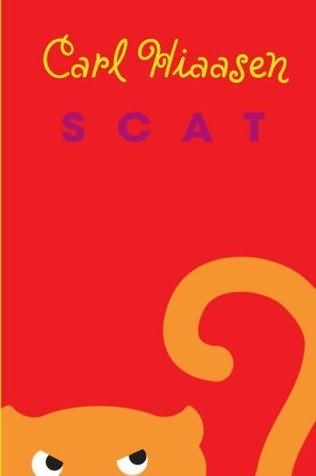 After HOOT and FLUSH, Mr. Hiaasen has produced a third ecologically-themed novel about animals and young humans. This one is, in my opinion, the best book he has written yet, in any category. The heroes of the story are Nick Waters and Marta Gonzalez, students in a middle school in southern Florida. Innocent of the angst of puberty, they are not yet a romantic pair. But they are best friends, fiercely loyal to each other, and one suspects that they will eventually fall in love.
After HOOT and FLUSH, Mr. Hiaasen has produced a third ecologically-themed novel about animals and young humans. This one is, in my opinion, the best book he has written yet, in any category. The heroes of the story are Nick Waters and Marta Gonzalez, students in a middle school in southern Florida. Innocent of the angst of puberty, they are not yet a romantic pair. But they are best friends, fiercely loyal to each other, and one suspects that they will eventually fall in love.
The book begins with Marta and Nick witnessing a tense confrontation, bordering on violence, between their passionately dedicated biology teacher, Mrs. Starch, and a loutish underachiever, Duane "Smoke" Scrod Jr. He is as stubbornly dedicated to not learning as Mrs. Starch is to teaching. The irresistible force collides with the immovable object, and sparks fly. "Smoke" storms out of the classroom, not to return for a long time - if ever.
The next day the class goes on a field trip, which is interrupted by a wildfire. Mrs. Starch disappears during the confusion. "Smoke," who has committed arson twice (he has Issues) is suspected of having started the fire--which is indubitably of intentional origin, not an accident--and of causing the disappearance of Mrs. Starch. During the fire, an eerie, blood-chilling sound is heard: the cry of a panther fleeing the flames.
The plot thickens; new characters appear. One of them will be familiar to readers of Carl Hiaasen's adult fiction: a man with the unlikely name of Twilly Spree, the protagonist of the novel Sick Puppy. An eco-avenger and defender of animals, Mr. Spree is called an "eco-terrorist" by his enemies, but he is a just man, out to see that the animals are protected and evildoers are punished. Even about that last, he is not as ferocious as he used to be; he has grown older, wiser, and mellower. His appearance suggests that Carl Hiaasen is now out to do for the Florida wilderness what William Faulkner did for the fictitious Yoknapatawpha County--to populate it with characters who freely move from one story to another, creating a wide and self-consistent world.
Indeed, this book is filled with fascinating characters, but I shall mention just three of them. The real main character, though we see her only towards the end of the novel, is the panther - Puma (Felis) concolor coryi - a Florida Panther, or Eastern Cougar, who once ruled the forests from Hudson's Bay to the Gulf of Mexico, but is now reduced to between 60 and 100 individuals in the swamps and prairies of southern Florida, having suffered ruthless persecution from humans. A very one-side enmity and war, as there has never been a single documented case of a panther causing any human deaths or injuries. The puma finally appears, up close and personal, mysterious and magical and beautiful, when the book is almost over. This is fiction's best big cat since Aslan.
We also get to meet a huge female macaw named Nadine, who is fluent in English, French and German, and is a ferocious defender of her beloved human companion. Used to human company, and quite humanized in her speech, Nadine is the structural opposite of the elusive wild panther. She is also very funny.
Last, and very much least, I should mention the villain of the story - a thoroughly despicable human who is out to get rich over the dead body of the panther and a plundered wilderness. Like all villains of Hiaasen's books for young people, he is cruel, ruthless, greedy, selfish - but, fortunately, also stupid.
I recommend this book, an exciting and memorable story, to readers of all ages. It's principal theme is, to slightly paraphrase the Bible: "The righteous (i.e., just and compassionate) person cares for the life of the beasts."
--Benjamin Urrutia
Recipes
Tofu and Fresh Tomatoes
Serves 3 - 4
This dish is wonderful for a light lunch or a lazy day brunch. Serve with plenty of crusty bread. Relax and enjoy.
5 T. extra virgin olive oil
1 sweet onion, cut in half and sliced very thin
1 sweet red bell pepper, sliced
2 cloves garlic, minced
2 fresh ripe tomatoes, peeled, seeded, and coarsely chopped
sea salt, to taste
cayenne pepper, to taste
1 package (14 – 16 oz.) organic tofu, soft or firm
freshly ground black pepper, to taste
In an omelet skillet, warm 3 T. olive oil on low heat. Add the onion and pepper; cook while stirring with a wooden spoon until tender (about 15 minutes). Increase heat and add garlic, tomatoes, sea salt and a little cayenne pepper. Stir until the mixture begins to boil. Decrease heat and simmer for 15 minutes. Then raise the heat to evaporate any remaining liquid.
In the meantime, squeeze extra liquid from the tofu. (I place the tofu between two dessert plates and set a can or jar on top while I’m preparing other parts of the recipe.) Season lightly with sea salt and freshly ground black pepper. Stir tofu and 2 T. extra virgin olive oil into tomato mixture after liquid has evaporated. Cook until tofu has heated through, stirring well with wooden spoon to mix well. Serve immediately; or may be eaten room temperature or cold.
This dish is wonderful for a light lunch or a lazy day brunch. Serve with plenty of crusty bread. Relax and enjoy.
--Angela Suarez
Savory Treats for Canine and Feline Friends
makes about 3 dozen treats
2 cups organic whole wheat flour
1 T. vegetarian broth powder
½ tsp. dried thyme
½ tsp. dried rosemary powder
1 tsp. dried parsley
1 T. organic evaporated cane juice (organic sugar)
1 cup spring water
2 T. safflower oil
Preheat oven 350° F.
In a large bowl mix together dry ingredients. Using a wooden spoon, stir in spring water. If dough seems too stiff or thick, add just a little more water to form a firm dough. Stir well to mix and let the dough rest in a warm place for 15 minutes. Add canola oil and allow to sit another 30 minutes. Shape tablespoons of dough into balls and slightly flatten to form little “cakes.” Bake for 30 minutes. Turn off oven and allow to cool in the oven with the door open. Store in airtight containers after completely cool.
--Angela Suarez
My Pilgrimage: Dan Golden
Three Faith Traditions: A Vegetarian View
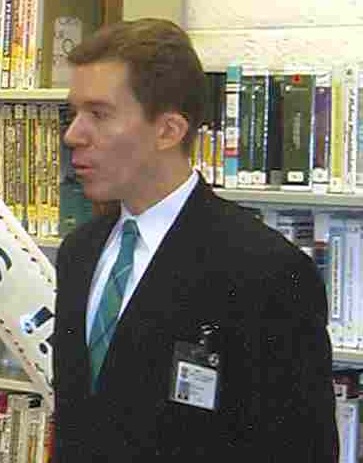 I am the product of a"mixed" marriage: my father was Jewish and my mother Scots/ English Episcopalian. My mother converted to Judaism under Reform auspices before marrying my father, and during my growing up years, the family was nominally Reform, while in fact largely secular. We had a tree at Christmastime, side by side with a Chanukah menorah. We ate the typical American diet, and I don’t recall the topic of vegetarianism ever having been discussed. Because of this blended heritage, I was open to learning about different faith viewpoints, and how they related to our non-human friends.
I am the product of a"mixed" marriage: my father was Jewish and my mother Scots/ English Episcopalian. My mother converted to Judaism under Reform auspices before marrying my father, and during my growing up years, the family was nominally Reform, while in fact largely secular. We had a tree at Christmastime, side by side with a Chanukah menorah. We ate the typical American diet, and I don’t recall the topic of vegetarianism ever having been discussed. Because of this blended heritage, I was open to learning about different faith viewpoints, and how they related to our non-human friends.
Judaism
In the spring of 1983, I came across Diet for Small Planet by Frances Moore Lappe which examines world hunger in the light of the waste of earth’s resources caused by the meat industry. Just days after I discovered Lappe’s work, a relative gave me a copy of Vegetarianism and the Jewish Tradition, a study by Louis Berman. Berman explained that the Jewish concept of tsa'ar ba'alei chaim, the obligation not to cause pain to living beings, is an important element of Jewish thought. Jewish scripture and religious literate include substantial discussions of compassion for animals, and strongly oppose the infliction of suffering on another living creature.
I began to experiment with a meatless diet in earnest around June of 1983, using recipes culled from Diet for a Small Planet as a guide. Many of my early dishes were simple peanut butter-and-jelly sandwich and rice-and bean numbers, and yet I found those very satisfying in their simplicity.
I also became more active in the Jewish faith and learned more about the affinity between vegetarianism and certain aspects of the Jewish faith. At a campus Hillel (Jewish student center), the Rabbi-counselor pointed out that Judaism is clear in mandating concern for animals. The Bible tells us explicitly, "The righteous man regardeth the life of his animal." Indeed, it is our duty to relieve the pain of any creature, even if it is ownerless. In the Hebrew Bible, the Fifth Commandment states specifically that animals must be allowed to rest on the Sabbath. Traditional Jewish practice disapproves of sport hunting, and the laws of kosher slaughter reflect a concern for the welfare of animals.
Unitarian Universalists
By the late 1980s, I was fully vegan. During this time, I became active with the Unitarian-Universalist Association, and discovered that, while the UUA doesn’t specifically promote a vegetarian lifestyle, the worldview of the faith is very sympathetic to vegetarianism and compassion for animals.
Unitarian-Universalism abides by Seven Principles, of which the Seventh calls for members to "respect the interdependent web of existence of which we are a part." Human beings, in this belief, are only a single strand in the intricate web of life. All living creatures are perishable, and depend on the earth for our survival.
The Seven Principles of Unitarian Universalism also establish the "inherent worth and dignity of every human being" and ask for "justice, equity & compassion in human relationships;" I found UUA members who understood those principles to include other species who also possess an intrinsic value, and whose rights parallel that of humans.
There is now an organization, Unitarian-Universalists for the Ethical Treatment of Animals, with a website that asserts “We acknowledge and affirm the kinship and interdependence of human and animal, and adopt ethics of interspecies compassion as an integral component of liberal religion."
Friends
 Although I enjoyed my experiences with UUA, my spiritual quest ultimately led me to the Society of Friends. In early 2009, I began a study regimen that included the works of George Fox, John Woolman, Elton Trueblood and Howard Brinton. I was delighted to find many Quaker references to care and compassion for our non-human friends, including one from William Penn: “It is a cruel folly to offer up to ostentation so many lives of creatures, as make up the state of our treats."
Although I enjoyed my experiences with UUA, my spiritual quest ultimately led me to the Society of Friends. In early 2009, I began a study regimen that included the works of George Fox, John Woolman, Elton Trueblood and Howard Brinton. I was delighted to find many Quaker references to care and compassion for our non-human friends, including one from William Penn: “It is a cruel folly to offer up to ostentation so many lives of creatures, as make up the state of our treats."
After several months of study, I was ready to attend my first Friends meeting. Over the past few months, I have come to appreciate how the Society of Friends does not accept as final the authority of any person or doctrine, but trusts in the continuing revelation of Truth and the Light. I understand that the Quaker witness is not simply a mode of worship, but a complete of way of life that centers on the presence of the Divine Light in every one, which implicitly includes all sentient beings of creation. This affirmation of the presence of the Light is central to the Quaker commitment to nonviolence and peace.
As a new member of the Society of Friends, I look forward to sharing in the meeting's work, especially that of the Animal Kinship Committee (PT's sponsor) of Orange Grove Friends Meeting and other like-minded organizations in the community. I already know that the Society of Friends meets my needs for worship and fellowship. This is my new spiritual home.
Having explored and lived several religions, I have made many lasting friendships, and I also gained a broader understanding of the ways these various faith traditions provide a foundation for care and love for our friends, the animals.
Poetry: Sappho (Seventh Century BCE)
 Evening Prayer (Fragment 95)
Evening Prayer (Fragment 95)
Bring them home, O Evening Star,
Whom Dawn dispersed so far--
Every kid, and lamb, and child
To their mother, from the wayless wild
--Translated by Benjamin Urrutia
O Evening Star, thou bringest all that's best:
The sheep, the goat, thou bringest home, to rest:
The child thou bringest to the mother's breast.
--Translated by Roberts (?)
Painting of Sappho by John William Godward
The Peaceable Table is
a project of the Animal Kinship Committee of Orange Grove Friends Meeting, Pasadena, California. It is intended to resume the witness of that excellent vehicle of the Friends
Vegetarian Society of North America, The Friendly
Vegetarian, which appeared quarterly between 1982 and
1995. Following its example, and sometimes borrowing from its
treasures, we publish articles for toe-in-the-water
vegetarians as well as long-term ones.
The journal is intended to be
interactive; contributions, including illustrations, are
invited for the next issue. Deadline for the October issue
will be Sept. 28, 2009. Send to graciafay@gmail.com
or 10 Krotona Hill, Ojai, CA 93023. We operate primarily
online in order to conserve trees and labor, but hard copy
is available for interested persons who are not online.
The latter are asked, if their funds permit, to donate $12 (USD) per year. Other
donations to offset the cost of the domain name and server are welcome.
Website: www.vegetarianfriends.net
Editor: Gracia Fay Ellwood
Book and Film Reviewers: Benjamin Urrutia & Robert Ellwood
Recipe Editor: Angela Suarez
NewsNotes Editors: Lorena Mucke and Marian Hussenbux
Technical Architect: Richard Scott Lancelot Ellwood

 Interestingly, an article in The Chicago Tribune on the same day pointed to the matter of obese physicians, who do not practice what they presumably know they ought to preach -- though the article did acknowledge that many patients find something comforting in a comfortably portly caregiver. (We might add, however, that an obese physician implicitly gives the client/patient permission to keep eating badly.)
Interestingly, an article in The Chicago Tribune on the same day pointed to the matter of obese physicians, who do not practice what they presumably know they ought to preach -- though the article did acknowledge that many patients find something comforting in a comfortably portly caregiver. (We might add, however, that an obese physician implicitly gives the client/patient permission to keep eating badly.)  “Animals can communicate quite well . . . . And generally speaking, they are ignored.” ~ Alice Walker
“Animals can communicate quite well . . . . And generally speaking, they are ignored.” ~ Alice Walker
 Time Magazine’s cover story “The Real Cost of Cheap Food” exposes the suffering farmed animals endure on a daily basis, and the reason behind it: demand for cheap food. From the overuse of antibiotics and hormones, to what farmed animals are fed, this article covers the major issues surrounding modern agriculture and the negative effects on our health, animals and the environment. See
Time Magazine’s cover story “The Real Cost of Cheap Food” exposes the suffering farmed animals endure on a daily basis, and the reason behind it: demand for cheap food. From the overuse of antibiotics and hormones, to what farmed animals are fed, this article covers the major issues surrounding modern agriculture and the negative effects on our health, animals and the environment. See 


 In her Foreword, Jane Goodall describes the time when she was working for her degree and the august faculty of Cambridge would give her grief for describing a chimpanzee mother as a "she" instead of an "it," as the prevailing dogma of the zeitgeist demanded. Things are a bit better now in academia, but there is still a long way to go.
In her Foreword, Jane Goodall describes the time when she was working for her degree and the august faculty of Cambridge would give her grief for describing a chimpanzee mother as a "she" instead of an "it," as the prevailing dogma of the zeitgeist demanded. Things are a bit better now in academia, but there is still a long way to go. After HOOT and FLUSH, Mr. Hiaasen has produced a third ecologically-themed novel about animals and young humans. This one is, in my opinion, the best book he has written yet, in any category. The heroes of the story are Nick Waters and Marta Gonzalez, students in a middle school in southern Florida. Innocent of the angst of puberty, they are not yet a romantic pair. But they are best friends, fiercely loyal to each other, and one suspects that they will eventually fall in love.
After HOOT and FLUSH, Mr. Hiaasen has produced a third ecologically-themed novel about animals and young humans. This one is, in my opinion, the best book he has written yet, in any category. The heroes of the story are Nick Waters and Marta Gonzalez, students in a middle school in southern Florida. Innocent of the angst of puberty, they are not yet a romantic pair. But they are best friends, fiercely loyal to each other, and one suspects that they will eventually fall in love. I am the product of a"mixed" marriage: my father was Jewish and my mother Scots/ English Episcopalian. My mother converted to Judaism under Reform auspices before marrying my father, and during my growing up years, the family was nominally Reform, while in fact largely secular. We had a tree at Christmastime, side by side with a Chanukah menorah. We ate the typical American diet, and I don’t recall the topic of vegetarianism ever having been discussed. Because of this blended heritage, I was open to learning about different faith viewpoints, and how they related to our non-human friends.
I am the product of a"mixed" marriage: my father was Jewish and my mother Scots/ English Episcopalian. My mother converted to Judaism under Reform auspices before marrying my father, and during my growing up years, the family was nominally Reform, while in fact largely secular. We had a tree at Christmastime, side by side with a Chanukah menorah. We ate the typical American diet, and I don’t recall the topic of vegetarianism ever having been discussed. Because of this blended heritage, I was open to learning about different faith viewpoints, and how they related to our non-human friends.  Although I enjoyed my experiences with UUA, my spiritual quest ultimately led me to the Society of Friends. In early 2009, I began a study regimen that included the works of George Fox, John Woolman, Elton Trueblood and Howard Brinton. I was delighted to find many Quaker references to care and compassion for our non-human friends, including one from William Penn: “It is a cruel folly to offer up to ostentation so many lives of creatures, as make up the state of our treats."
Although I enjoyed my experiences with UUA, my spiritual quest ultimately led me to the Society of Friends. In early 2009, I began a study regimen that included the works of George Fox, John Woolman, Elton Trueblood and Howard Brinton. I was delighted to find many Quaker references to care and compassion for our non-human friends, including one from William Penn: “It is a cruel folly to offer up to ostentation so many lives of creatures, as make up the state of our treats."  Evening Prayer (Fragment 95)
Evening Prayer (Fragment 95)